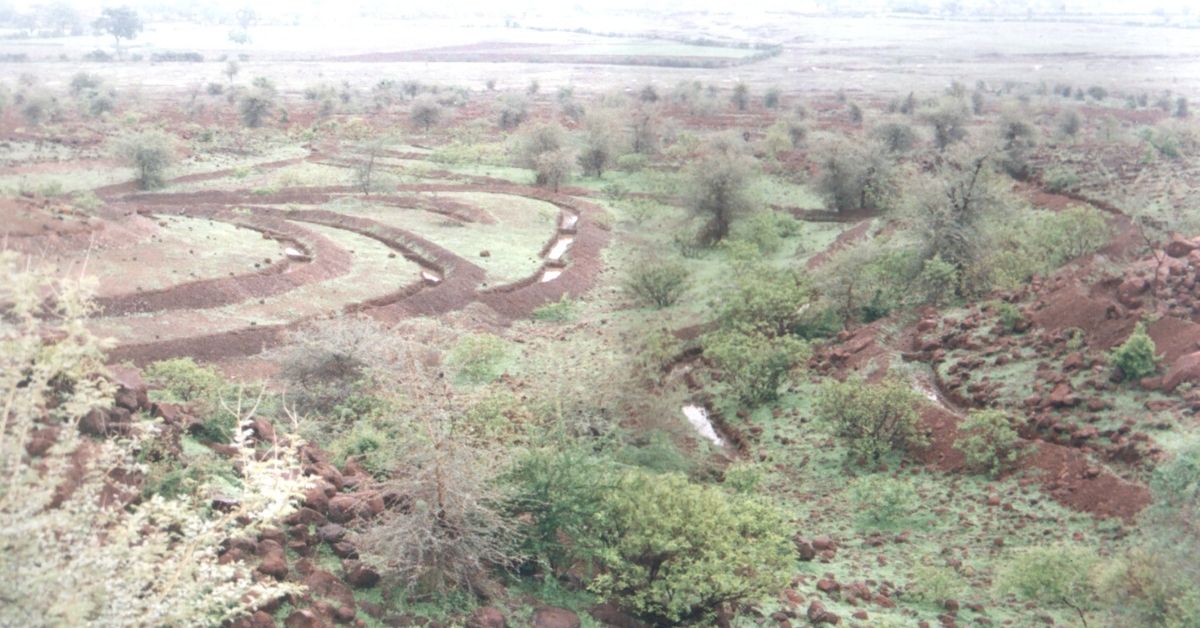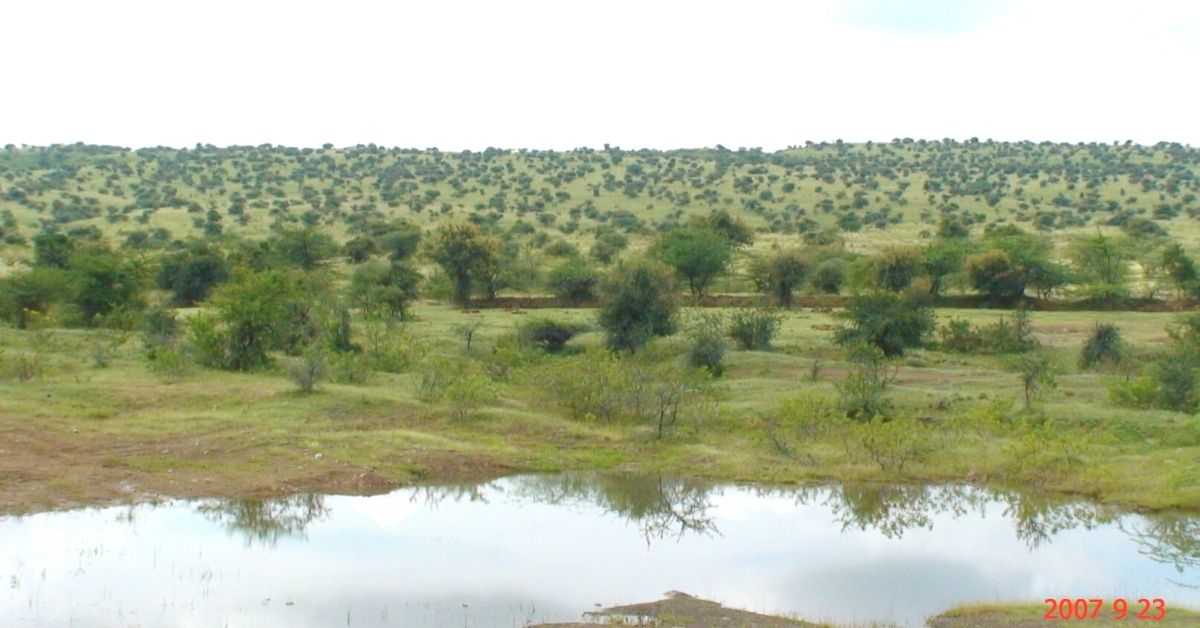The Lamkani village is roughly a 40 km drive from Dhule in Maharashtra. The name is derived from the Marathi word for ‘long’ and ‘kani’ meaning ‘ears’. So together it translates to — long ears. The village was christened so owing to the long-eared rabbits that frequented the green pastures of the village. The pastoral land served as a habitat for many grassland species and provided fodder for cattle too.
The situation degraded by the 1970s when the region experienced droughts that only worsened. By the late 1990s, the prevailing drought conditions turned the area into barren land, making it difficult for its inhabitants and cattle to survive.
The villagers started migrating, and many abandoned their cattle, as the fodder required to be outsourced was expensive.
But two decades on, the village has restored its lost glory by rejuvenating and reviving its grasslands, all thanks to Dhananjay Newadkar, a pathologist and native, who initiated the efforts and mobilised the villagers in the conservation work.
The village has restored 400 hectares of barren land and implemented watershed management schemes, making the village drought-free.
Initiative born out of an accident

Interestingly, the efforts started with a tragedy that befell Dhananjay in 1999 when he suffered a near-death accident that left him bedridden for over six weeks. “I completed my medical studies from Pune in 1991 and started my practice in Dhule. The accident occurred during my trip from Dhule to Shahada,” he tells The Better India.
While Dhananjay was recovering in the hospital, many villagers visited him. A common discussion topic was the worsening water crisis and deteriorating land conditions in the village. Dhananjay pledged that he would work towards solving this water scarcity once he recovered from his injuries.
However, he had no experience in environmental and water conservation. So, after his recovery, he visited Hiware Bazar and Ralegan Siddhi village, which are well-known for their watershed management techniques. The visits made him realise that the 600-hectare Govardhan hill could help conduct the watershed work.
“I tried to understand the techniques and community efforts required and learned that every drop of the 400 mm rains the region receives would have to be percolated. I returned with lessons on the implementation of the conservation measures,” he recollects.
The 56-year-old did not have the faintest idea about how difficult the initiative would be. “The first step was to appeal to villagers to stop uncontrolled grazing of cattle. We put a ban on tree cutting and made them understand the importance of watershed management,” he says.
For the next couple of years, Dhananjay undertook massive awareness programmes along with a handful of villagers who supported him.
Education through song & dance

“We took the help of kirtankars, a community of spiritual storytellers who used dancing and singing to convey their message, along with folk artists known as tamasha artists. There are about 150-200 such events during the year, and it became a good platform to reach mass audiences through the medium as the people were familiar with it. Besides, we carried a small television to households, schools and other public events to show the importance of the environment and its conservation,” Dhananjay says.
He adds that by 2002, the locals started understanding the importance and expressed willingness to take on the conservation efforts. Meanwhile, one water arresting structure was created at the base of the Govardhan hill, demonstrating the percolation of water, which gave the villagers hope. A set of guidelines were then drawn and required to be followed by the people.
“We stopped grazing starting with 50 hectares of land each year. The community decided collectively to practice rotational grazing. It ensured that at least one portion of land remained untouched each year. A sum of Rs 50,000 for cattle grazing was usually given to the panchayat. But the panchayat waived off the fee to recognise the support from the grazing community, Dhangar,” he says.
Simultaneously, concrete barrages, trenches and loose boulder structures were built to arrest the water on the slopes flowing down the hillock.
By 2003-04, the conditions improved as the grass grew with water percolation and moisture retention.
As the work showed results, videos were shot and shown during village events. “People felt glad and proud to be showcased on television for their contribution. More people and youngsters started joining the cause,” he adds.
Dhananjay says the village also received a fund of Rs 1.5 lakh from Pune-based Watershed Organisation Trust (WOTR) and Rs 65,000 from the village panchayat for watershed management.
Overcoming drought

The percolation helped increase the groundwater table by 10 to 15 feet, making the village tanker-free in 2006-07. “That year, the borewell overflowed, and the villagers were overwhelmed. The news reached the then-District Collector, Bhaskar Rao Munde, who paid a visit to the village. The event also received media publicity,” Dhananjay says that the attention only encouraged the villagers further.
The residents who once criticised or expressed doubts over the project witnessed the positive change and started supporting the conservation efforts.
Vijaya Patil, a participant in the water conservation work, says, “The irrigated land increased from 50 hectares to 300 hectares. The farmers began cultivating crops round the year.”
“Earlier, the farmers could hardly grow one crop a year, but now they grow multiple crops — including cotton, bajra, jowar, onion and fruit varieties. Now there is no shortage of water for the cattle, farm or even human consumption,” Vijaya says, adding that about 4,000 litres of milk are produced from the village daily.
Ensuring the success continues, the teachers are creating an environment-sensitive generation to protect the grasslands.
“The English School Lamkani, providing secondary education, conducts seed collection and dispersal camps every year. The students collect about two quintals of seeds from the neighbouring areas and spread them across the hillock. The success rate is less as the land is rocky and has less soil content. However, it is an effort,” says Dnyaneshwar Shelar.
Dnyaneshwar says the students visit the hills to study biodiversity and learn about different grass species. “The Pawana grass, scientifically known as Sehima nervosa, is becoming rare, and efforts are underway to conserve it. This grass variety is known to have good health effects for the cattle and improve fat percentage in the milk too,” he adds.
“We do not plant any trees. The grass seedlings are collected by the students and are then grown into saplings in a nursery in collaboration with the forest department. The saplings are then dispersed by the students,” the teacher says.
He says that students actively participate in protecting the grasslands from fires. “Every summer, there are at least a couple of grassland fire incidents and students have been training to form teams and deal with them. The students and the community work together to douse the fires and mitigate the crisis within minutes. It is not only because they are trained but also that they have the sense of belonging and ownership towards the grasslands now,” Dnyaneshwar explains, adding, “They know what this loss could mean after years of conservation efforts.”
The success of the village was made into a documentary and shown across 900 villages by Paani Foundation.
Dhananjay says he feels proud that every person has become a stakeholder in the conservation efforts. “I am confident that the residents are capable of protecting the grasslands. It is also an example that it is possible to beat drought, making villages resilient,” he adds.
Edited by Yoshita Rao
No comments:
Post a Comment